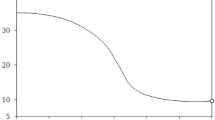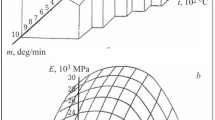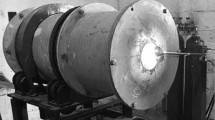Features of an electrothermal unit periclase-chromite lining operation during treatment of lead- and zinc-containing products are studied. It is established that during operation a refractory lining is subjected to erosive and corrosive wear. The nature and degree of refractory breakdown depends on its location within elements of an electrothermal unit. Greatest wear occurs for a refractory lining in a smelting furnace roof and slag belt.
Similar content being viewed by others
Avoid common mistakes on your manuscript.
INTRODUCTION
The main methods for processing lead raw material in Kazakhstan nonferrous metallurgy are pyrometallurgical: shaft reduction melting of agglomerate, reaction melting on hearths, and reduction reaction melting in an electric furnaces. Processing lead raw material concerns reduction-reaction melting in electrothermal units. This method is used to process lead concentrate, copper dross, metallurgical dust, and including silver foam [1–4].
The aim of this work is to study features of service and corrosion of periclase-chromite refractories in an electrothermal unit for processing silver foam in the OA Kaztsink Lead Plant.
EXPERIMENTAL PART
An electrothermal unit, processing silver foam, consists of individual elements: melting furnace, zinc vapor condenser, and a dust catching unit (Fig. 1). The main elements of the electrothermal system for processing silver foam is a three-electrode furnace of round construction. The internal elements of the electric furnaces (roof, walls, and hearth) and condenser lining are of periclase-chromite refractory composition. Condenser dust and gases enter an inertia dust catcher, fitted with an explosion-proof valve, and then into bag filters. The furnace and condenser operate under pressure, controlled automatically.
The silver foam melting process is carried out in an electric furnace in a reducing atmosphere at 1000 – 1200°C. The temperature of the vapor and gas mixture beneath the roof is 1000 – 1250°C, in the short gas conduit it is 950°C, and in the condenser it is 650 – 700°C.
Processing of silver foam includes zinc distillation with condensation as liquid metal, and preparation of silver-containing lead. At the end of melting silvery lead enters through a siphon into a mold and is sent for cupellation.
Slag thickens as impurities accumulate, and it is replaced by new slag. Together with furnace heating the condenser is heated with cooling gases at a temperature of 700°C. As liquid zinc of the zinc bath melts a stirrer in installed in the condenser for sprinkling metal. The stirrer rotation frequency is 500 – 900 rpm. The temperature of zinc in the siphon dish is 550 – 600°C. Zinc is poured out into blocks and sent for zinc refining in the smelting workshop.
Thus, the inner surface of a refractory lining is in contact with corrosive molten metal and slag under action of high temperature and a reducing atmosphere. Service conditions for individual lining elements differ significantly from each other and depend on refractory location. The greatest refractory breakdown is observed in the slag belt and the roof of an electric furnace close to electrodes, whose lining replacement is carried out after each 1.5 – 2 months, and this destabilizes installation operation as a whole.
At the time of selecting a refractory lining sample from an electrothermal unit, processing silver foam, it was made from periclase-chromite refractory with the following property indices: ultimate strength in compression 21 – 23 MPa, open porosity 22 – 25%, temperature for the start of deformation under load 1530°C, thermal shock resistance 2 – 3 thermal cycles, containing 25.8% Cr2O3, 44.7% MgO, and 6.6% SiO2.
Chemical and mineral compositions of periclase-chromite refractory from an electrothermal unit lining were studied using chemical, microscopic, and x-ray structural analyses methods (Tables 1, 2).
The main refractory minerals before service are periclase and chrome spinelid with a typical collection of lines for them in a diffraction pattern (periclase — (2.43, 2.11, 1.49) × 10−1 nm; chrome spinelid — (4.84, 2.61, 2.51, 2.08) × 10−1 nm), and usual optical properties. Within the refractory structure before service there are also secondary spinels of complex composition and silicates (merwinite, forsterite). Aggregates formed from grains of the main periclase and chrome spinelid phases are cemented with a fine-grained mix of complex composition. Refractory structure has a variable grain size and is quite porous (Fig. 2).
In order to study wear features of periclase-chromite refractory samples were collected from different elements of the electrothermal unit: melting furnace (roof and slag belt), and condenser. Samples of periclase-chromite refractory after service were also studied by means of chemical, microscopic, and X-ray structural methods of analysis. The chemical composition and structure-phase changes occurring within periclase-chromite refractory after service are provided in Tables 1 and 2.
Research results showed that during service refractory experiences significant chemical and mineralogical changes. A considerable amount of nonferrous metals and slag components are introduced into the composition, reacting selectively with refractory minerals with new phase formation, which leads to lining corrosion-erosion breakdown.
DISCUSSION OF RESULTS
Features of Structure and Phases Changes of Periclase-Chromite Refractory After Service in an Electric Furnace
Electric Furnace Roof
A sample was collected in the area roof directly in contact with electrodes. Crack formation was noted as a result of action of high temperature and development of significant thermal stresses within a refractory lining of the brick selected after service. Zone formation is clearly observed. Three zones are separated visually within refractory after service in the furnace roof: working, transition, and little changed.
Working zone. Thickness ~15 mm, color dark brown, dense structure, and 8% open porosity. Compaction of the refractory structure after service occurs as a result of action of high heater temperature and additional sintering of the refractory mix.
There are significant phase changes within the zone, caused by action of high temperature and gaseous CO. As a result of migration of 3-valent cations from the chrome spinelid composition, there is a reduction in the amount of these elements within the working zone (see Table 1). The main refractory mix is aggregates of periclase and broken chrome spinelid grains, cemented with silicate binder, consisting of forsterite, monticellite, and secondary spinels of complex composition (Mg,Fe)O·Al2O3, formed by reaction of periclase with chrome spinelid components (Fig. 3). The refractive index established for secondary spinels is about 1.8. Single grains of Na2O·MgO·6SiO2 and zinc metal are noted.
The transition zone is represented by a specimen of light-brown color. Structural elements are aggregates of coarse cracked grains of chrome spinelid and periclase, impregnated with secondary spinel precipitates of complex composition. Within chrome spinelid grains there are inclusions with a clear reflecting capacity, exhibiting magnetic properties and related to magnetite Fe3O4. The role of binder is fulfilled by fine grains of periclase and silicates: Mg2SiO4 is an anisotropic phase, optically biaxial, and negative with Ng = 1670; Np = 1.640 and Na2O·2MgO·6SiO2 — colorless, and monoclinic with N av = 1.56.
The little changed zone is macroscopically represented by lumps of dark color with a brown shading, and 20% porosity, which is somewhat lower than for refractory before service, and this is a result of some compaction of the refractory structure as a result of sintering under action of temperature in a reducing atmosphere.
The phase composition is represented by refractory minerals before service. Periclase and chrome spinelid are present in approximately equal amounts. Grains of chrome spinelid are coarse (≤1 mm), cracked, and experiencing some changes. The binder, fastening periclase and chrome spinelid is of complex composition. It is represented by forsterite Mg2SiO4, secondary spinel of green-brown color with N = 1.84 – 1.85, a small amount of brownmillerite Ca4Al2Fe2O10 of brownish-red color with pleochroism and N = 2.
Electric Furnace Slag Belt
A refractory sample was collected in the area of direct contact of slag with lining. Visually the refractory is separated into four zones: working crust, working, transition, and little changed (Fig. 4).
Refractory microstructure after service in slag belt. Zone: a) working skin; b ) working; c) transition; d ) little changed; 1 ) periclase; 2 ) changed chrome spinelid; 3 ) secondary spinel; 4) Na2O·CaO·SiO2; 5 ) (Mg,Zn)O solid solution; 6 ) Zn; 7 ) Pb; 8 ) ZnAl2O4 gahnite; pores are dark. Reflected light. ×210.
The working crust is a specimen of dark color with a size of 5 – 15 mm with a different size grain dense structure, and open porosity of this refractory zone was 4%. Areas were observed with icicle-like formations. The main crust phase is a slag component, whose presence is confirmed by a collection of lines typical for it in a diffraction pattern Na2O·CaO·SiO2 ((3.70, 2.65, 2.16, 1.88, 1.53) × 10−1 nm). This is a colorless phase with refractive index N = 1.600 – 1.615 (Fig. 4a ).
Periclase is represented by a solid solution (Mg,Zn)O ((2.169, 1.49) × 10−1 nm), and its content in a sample is 20 – 25% (Fig. 4a ). Chrome spinelid is not distributed uniformly within the sample structure, but concentrated in individual areas. Grains are porous, cracked, and coarse (up to 800 μm). ZnO, β-Ca2SiO4, and metal phases, i.e., zinc and lead, are present in small amounts (see Table 2).
The working zone is dark in color with grains of different size and dense structure, and 10% open porosity. The main mass comprises cracked grains of chrome spinelid with a size of ~1 mm (Fig. 4b ). Within a sample about 20% of periclase is present in the form of solid solution with zinc. These two phases are cemented by silicate binder of larnite β-Ca2SiO4 with a collection of lines for it in a diffraction pattern ((3.83, 2.87, 2.78, 2.74, 2.60, 2.28) × 10−1 nm) and glass. Presence of zinc oxide inclusions, secondary spinels, and zinc metal is established.
It is apparent that significant refractory wear in contact with molten slag may be explained by its penetration though binder pores into the depth of refractory where there is reaction of slag components (Na2O, CaO, SiO2) transformed anew into melt composition, increasing is viscosity. More refractory newly formed Ca2SiO4 phase remains within the refractory.
Proof of the occurrence of these processes may be a reduction in MgO and Cr2O3 content and levelling of the amount of SiO2 and CaO within samples (see Table 1).
The transition zone is a sample of dark color, different grain size, with open porosity ~8%. The main structural elements are aggregates consisting of grains of cracked chrome spinelid and periclase with increased refractive index N ≈ 1.835 – 1.840 as a result of entry of zinc into its composition (Fig. 4c ). The amount of this periclase within a sample is 25 – 30%. A small amount of original colorless periclase with normal optical constants is also present. In addition, within a sample of the transition zone there are monticellite, spinel phase, gahnite ZnAl2O4 (2.86, 2.44, 1.43) × 10−1 nm) of cubic syngony, crystals of octahedral habit and isotropic with N ≈ 1.8, secondary spinel (N ≈ 2), glass, and zinc and lead metal.
The little changed zone is dark in color, more porous than the preceding zone, and open porosity is 12%. The main phases are cracked deformed grains of chrome spinelid and periclase (Fig. 4d ). In transmitted light presence has been established of two forms of spinel, i.e., yellow-brown (N ≈ 2) and bluish color (N ≈ 1.8), classified as gahnite ≈ ZnAl2O4 ((2.86, 2.44, 1.43) × 10−1 nm). Presence of periclase with inclusions of zinc metal from spots to beads with a size up to 30 μm was established. Within a sample there is up to 3.5% monticellite and a little glass.
Features of Structure and Phase Changes of Periclase-Chromite Refractory After Service in a Condenser
Condenser
A sample, collected from the condenser roof lining is represented by a specimen dark in color with a yellowish shade at the surface. Two zones are separated within it, i.e., working and transition with little changed.
The working zone, being a result of refractory contact with zinc vapor, has open porosity ~18%. From results of chemical analysis within it there is a significant amount (up to 25%) of zinc. In studying a microsection in microscope reflected light it was established that the main phases are periclase of irregular and rarely round shape, and coarse grains of chrome spinelid (Fig. 5a ), cemented by a binder mix consisting of ZnO ((2.82, 2.60, 2.48) × 10−1 nm) of hexagonal syngony, glass with N ≈ 1.510 – 1.515, spinel of red-brown color, and individual forsterite grains. Also detected was 5 – 7% zinc metal. Sometimes within chrome spinelid grains it is possible to observe magnetite Fe3O4 inclusions (Fig. 5b ).
Transition and little changed zones. Macroscopically the sample was represented by a solid lump of dark color with metal inclusions. As in the previous sample, the main minerals are periclase, coarse grains of cracked chrome spinelid with reduced refractive index, i.e., the result of diffusion of some of the iron cations from chromite with formation of Fe3O4, filling cracks within its crystals.
Within a sample there are both colorless and brown shade periclase with disseminated secondary spinel. Zinc metal is associated with magnetite (Fig. 5b ). A small amount of forsterite is observed with a normal refractive index, red-brown spinel, and glass phase (N ≈ 1.510 – 1.515).
CONCLUSION
Periclase-chromite refractory during service in an electrothermal unit, processing silver foam, undergoes significant degradation. The degree and form of refractory breakdown depends on its location within a metallurgical unit.
In the roof of an electric furnace most refractory wear occurs in the contact region with electrodes, and this is connected with occurrence of high thermal stresses and chemical reaction of refractory phase with corrosive lead-zinc and slag distillates and gases.
Rapid refractory corrosion-erosion wear is observed in the slag belt of an electric furnace as a result of mechanical and chemical action of molten metal and slag on a lining. Slag components react with refractory minerals, i.e., chrome spinelid and periclase, with formation of readily melting compounds washed out from the refractory composition by a stream of melt. Zinc and lead metal penetrate through pores of the binder deep into refractory, forming a solid solution (Mg, Zn)O, or are present in the form of Zn and Pb metal inclusions. These processes weaken the overall structure of an object, and this intensifies refractory lining breakdown.
The least refractory lining wear is established in a electrothermal unit condenser.Wear occurs mainly as a result of penetration of zinc vapor through binder pores into refractory with formation of (Mg, Zn)O. accumulation of zinc within the refractory structure leads to gradual refractory lining growth.
References
I. R. Polyvyannyi, Oxygen and Natural Gas in Zinc Metallurgy [in Russian], Nauka, Alma-Ata (1976).
A. A. Biryukova, T. A. Tikhonova, and A. V. Voronina, “Effect of gas atmosphere on structure and phase transformations occurring in the refractory system Pb(PbO),” Énergotekhnol. Resurs., No. 6, 41 – 46 (2009).
A. A. Biryukova, T. A. Tikhonova, and A. V. Voronina, “Processes of mineral formation in the refractory system Pb(PbO),” Kompleks. Ispol. Mineral. Syr’ya, No. 2, 78 – 85 (2008).
A. A. Biryukova, T. A. Tikhonova, and A. V. Voronina, ““Processes of mineral formation in the refractory system Zn(ZnO),” Kompleks. Ispol. Mineral. Syr’ya, No. 4, 63 – 69 (2008).
Author information
Authors and Affiliations
Corresponding author
Additional information
Translated from Novye Ogneupory, No. 6, pp. 3 – 8, June 2015.
Rights and permissions
About this article
Cite this article
Biryukova, A.A., Tikhonova, T.A. & Boronina, A.V. Operating and Corrosion Features of Periclase-Chromite Refractories During Electrothermal Treatment of Lead-Containing Products. Refract Ind Ceram 56, 230–235 (2015). https://doi.org/10.1007/s11148-015-9821-5
Received:
Published:
Issue Date:
DOI: https://doi.org/10.1007/s11148-015-9821-5









